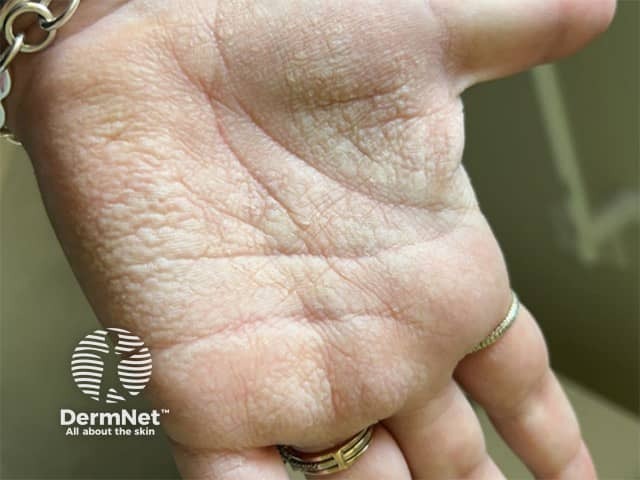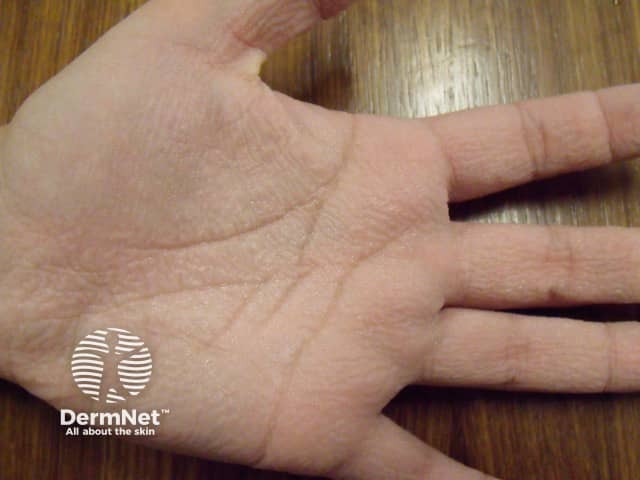Main menu
Common skin conditions

NEWS
Join DermNet PRO
Read more
Quick links
Author(s): Dr Tyler Stevens, Counties Manukau DHB, New Zealand (2023)
Previous contributors: Dr Matthew Ludgate (2005); Dr Ebtisam Elghblawi, Dermatologist (2017)
Reviewing dermatologist: Dr Ian Coulson
Edited by the DermNet content department
Introduction Demographics Causes Clinical features Diagnosis Differential diagnoses Treatment Outcome
Aquagenic wrinkling of the palms is a rare condition characterised by transient oedematous skin of the palms after contact with water. It is most commonly observed in patients with cystic fibrosis or carriers of the cystic fibrosis gene. It is an exaggeration of the normal finger wrinkling that occurs when fingers are soaked in water for a prolonged period.
Aquagenic wrinkling of the palms has previously been called transient reactive papulotranslucent acrokeratoderma, aquagenic palmoplantar keratoderma, aquagenic acrokeratoderma, and aquagenic syringeal acrokeratoderma.

Swelling and wrinkling of the palmar skin, arising within 5 minutes after water immersion

Excessive wrinkling noted after 5 minutes of water immersion (AWP-patient2)
The disease has a female predominance and mainly affects those with the following risk factors:
In some cases, aquagenic wrinkling of the palms can be idiopathic.
The cause of aquagenic wrinkling of the palms is unknown but is thought to relate to sweating. It may be caused by a salt imbalance in the skin cells, which results in increased water retention within these cells and increased transepidermal water loss.
Some cases have been related to medications, such as aspirin, non-steroidal anti-inflammatories, and some antibiotics, possibly due to drug-induced dysregulation of skin aquaporin, a protein that is responsible for water transport across the cell membrane.
The cause of aquagenic wrinkling in cystic fibrosis (CF) is more specific. It appears to be due to one, or a combination, of the following:
Aquagenic wrinkling of the palms is characterised by the appearance of a palmar eruption of white or translucent papules and plaques following brief exposure to water. Patients may report an uncomfortable tight, burning, or itchy sensation during an eruption.
Unlike physiological wrinkling which takes approximately 11 minutes of water exposure, aquagenic wrinkling of the palms often occurs after just 3 minutes. It takes longer to appear in mutation carriers than in patients with cystic fibrosis. Wrinkling typically disappears within 10–60 minutes after drying, however can persist for longer periods.
Aquagenic wrinkling most commonly presents with symmetrical involvement of the palms and sometimes the soles of the feet. Other reported sites include the forehead, heel, and dorsal aspect of the fingers.
The diagnosis of aquagenic wrinkling of the palms is usually clinical. The palmar eruption can usually be readily demonstrated by exposing the hands to water for 7 minutes (‘hand in the bucket’ sign).
A skin punch biopsy may be taken to confirm the diagnosis. Histological findings may show:
Aquagenic wrinkling of the palms may present similarly to other conditions. Differential diagnoses include:
General measures to prevent direct exposure to water can be tried including barrier creams, gloves, and petroleum jelly, however, these are usually ineffective.
An antiperspirant such as 20% aluminium chloride hexahydrate applied to the palms at night is the first-line treatment and can dramatically improve symptoms.
Other treatments that can be tried include:
Aquagenic wrinkling of the palms is a self-limiting condition and many patients are not bothered by the symptoms. However, it is strongly associated with cystic fibrosis and a diagnosis of aquagenic wrinkling should prompt an early workup for cystic fibrosis.